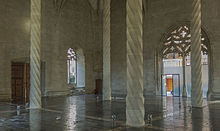Llotja de Palma
Llotja dels Mercaders (also known as Llotja de Palma and La Lonja de los Mercaderes ) is a historic building on the island of Mallorca and is considered one of the masterpieces of bourgeois Gothic architecture in the capital Palma .
location
The building is located in the south of the old town, in the immediate vicinity of the La Seu cathedral on the main street Avinguda de Gabriel Roca (MA 1) in the direction of the port of Palma.
description
The Llotja has a rectangular floor plan. On the outside, the building has four facades with octagonal towers as each side. Ten smaller towers, which correspond to the distribution of the sections inside, also serve as buttresses. The monumental entrance gate on the main facade in the east should be emphasized. It has tapered archivolts with plant-shaped decoration and an angel sculpture of Ángel de la Mercadería (angel of the merchandise) in the tympanum . Enough light comes into the interior through the large windows with lush tracery .
history
Construction began in 1426 according to the plans of the architect Guillem Sagrera from Felanitx , who, however, was unable to finish this building within the prescribed period of 12 years. The building was not completed until 1447 by the builder Vilasolar with the work on the last two large windows.
use
After completion, it was the seat of the maritime trade exchange, which was founded in Barcelona by a privilege of King Martí I from 1403 and was located in this building from 1452 until it was dissolved in the 1830s. This body dealt with the regulation and protection of the trade, as well as the maintenance of the port of the city of Palma. Business transactions were carried out in the Llotja building and it also served as an exchange.
After the decline of sea trade, la Llotja was used as a simple depot for goods for some time. An artillery factory was set up during the Napoleonic Wars . After the War of Independence, the cannon factory was dismantled, renovated and used as a courthouse. Between 1886 and 1962 it housed a museum of painting and archeology.
Art exhibitions are currently held in la Llotja.
Web links
Coordinates: 39 ° 34 ′ 6 " N , 2 ° 38 ′ 39.5" E



